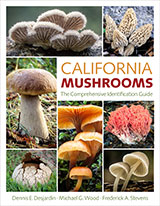The North American Species of Pholiota
47. Pholiota tahquamenonensis sp. nov.
Illustrations: Text figs. 144-145.
Pileus 2.0-2.5 cm latus, planus, margine laceratus, "buckthorn brown," deinde "pale pinkish buff," disco "warm buff," glabrosus, viscidus. Caro fragilis; odore et gustu mitis. Lamellae adnatae, paene "buckthorn brown," latae, confertae demum subdistantes, demum ventricosae. Stipes 2 cm longus, 3 mm crassus, supra pallidus, infra obscure flavido-brunneus, ad imum albae rhizomorphae. Velum fasciens tenuem, medianum,membraneaceum annulum. Sporae 6-8 x 3.8-4.5 (5) µ, ellipsoideae demum subovoides, leves, truncatae. Pleurocystidia 36-47 x 2-3 x 3-4 µ, ampullacea, cervice longa, apicibus acuta vel subcapitata; cheilocystidia similia. Cuticula gelatinosa. Specimen typicum in Herb. Univ. Mich. conservatum est; lectum in Tahquamenon Falls State Park, Michigan, 6 July, 1959, Smith 60944.
Pileus 2-2.5 cm broad, plane with a lacerate margin in age, glabrous, moist, viscid when young, "buckthorn brown" (yellow-brown) fading to pale pinkish buff, rather strongly hygrophanous, disc finally pale yellow ("warm buff"). Context fragile, odor and taste mild.
Lamellae adnate, seceding, broad, close to subdistant, dull yellow-brown (near "buckthorn-brown"), ventricose in age, edges slightly fimbriate.
Stipe 2 cm long, about 3 mm thick, equal, pallid above, dull yellow-brown below, with white rhizomorphs at the base, with a thin median membranous annulus.
Spores 6-8 x 4-5 µ, smooth, in face view mostly ovate but varying to elliptic, in profile obscurely inequilateral to ovate, wall thickened to about 0.25 µ, apex obscurely to distinctly truncate from an apical pore, apiculus minute but present as seen in a profile optical-section; tawny to pale tawny in KOH individually, paler in Melzer's reagent individually but in groups slightly dextrinoid.
Basidia 20-24 x 5-7 µ, clavate, 4-spored, hyaline in KOH, yellowish in Melzer's reagent. Pleurocystidia rare to scattered, most abundant in hymenial area between the gills, 35-50 x 2-3 x 3-4 µ, very narrowly ventricose at base and tapered to an acute to subcapitate apex, the neck flexuous, rarely the apical region moniliform to variously contorted, hyaline, thin-walled, smooth. Cheilocystidia 30-50 x 4-7 x 3-4 µ, hyaline, thin-walled, smooth, more or less ventricose at base, neck narrow and flexuous, often somewhat moniliform in apical third. Caulocystidia none located.
Gill trama of subparallel non-gelatinous hyphae with inflated cells, the cells shorter near the pileus trama and more elongate toward the gill edge, 4-14 µ or more wide, walls smooth, thin, hyaline to yellowish in KOH, and only slightly more yellowish in Melzer's reagent. Pileus cutis a thin layer of appressed gelatinous narrow (2-3.5 µ) tubular thin-walled hyphae. Context hyphae 4-12 µ diam., walls brownish to hyaline in KOH, hypodermial area not structurally differentiated. Clamp connections present. All hyphae inamyloid.
Habit, Habitat, and Distribution: On rotten wood, Tahquamenon Falls State Park, Michigan, Luce County, July 6, 1959. Smith 60944, type.
Observations: This species is smaller than P. veris and many of the cheilocystidia are almost tibiiform as in stirps Sideroides of Galerina. This feature at once distinguishes it from P. veris microscopically, if one has depauperate specimens of the latter at hand. Here again the species is not known from more than the type locality and type collection, but we felt it worthwhile to place it on record because of the cheilocystidia and the general stature of the Galerina sideroides group-at least in the larger basidiocarps.

